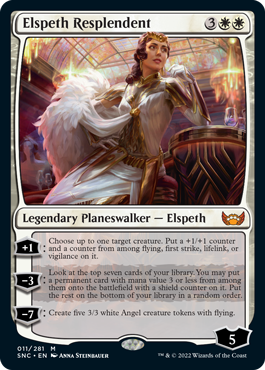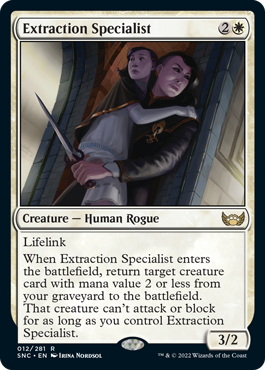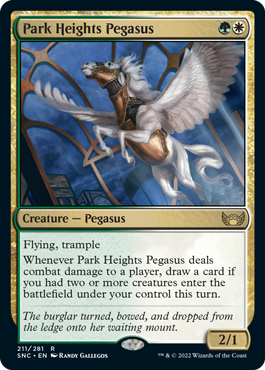Word on the Streets of New Capenna, Part 2
Last week, I started sharing some Streets of New Capenna card-by-card stories. This week, I have more stories about designs, none of which talk about Charms. Let's get started.
Elspeth Resplendent

It turns out Capenna (the plane New Capenna is on) is Elspeth's homeworld, so how could we not include her in the story? That meant we had to make a planeswalker card for her.
[Elspeth] (version #1)
1WW
Legendary Planeswalker — Elspeth
Starting Loyalty – 1
CARDNAME enters the battlefield with a shield counter on her.
+1: Creatures you control gain vigilance until end of turn.
-2: Create a 1/1 white Soldier creature token for each creature you control.
The first version had one static ability and two loyalty abilities. The static ability came about because we've been trying to include more set mechanics on our planeswalkers. We realized that shield counters could work on permanents other than creatures, so it seemed cool to put it on a planeswalker, and Elspeth was the best candidate being mono-white. (Vivien is mono-green, and Ob Nixilis is black-red.)
The problem ended up being that planeswalkers are more often destroyed through attack than a destruction effect, so it just wasn't useful enough. The other two abilities were very much in Elspeth's power suite. She's known for making tokens in particular, with four of her previous five cards doing so (and the fifth putting a specific creature onto the battlefield).
[Elspeth of New Celestia] (version #2)
1WW
Legendary Planeswalker — Elspeth
Starting Loyalty – 3
+1: Creatures you control get +1/+1 and gain your choice of first strike or vigilance until end of turn.
-2: Create two 1/1 green and white Citizen creature tokens.
-6: SOMETHING DOPE
The Set Design team got rid of the static ability and returned to an "old school" design—small plus, small minus, big minus ultimate. This version keeps the same effects from the first version but pumps them both up, adding more effects to the first ability and making the second ability create an additional creature token.
This version also shows off something I don't talk about much, what I'll call the throw-forward. Sometimes, you're not quite sure what you want to do for part of a card, so you just state the essence of what you want. "Hey people down river, which often are still us, make sure you do this."
[Elspeth of New Celestia] (version #3)
3WW
Legendary Planeswalker — Elspeth
Starting Loyalty – 4
+1: Put two counters of your choice from among +1/+1, flying, lifelink, first strike, and vigilance on up to one target creature.
-2: Look at the top seven cards of your library. Put a nonland permanent card from among them onto the battlefield with a shield counter on it. Put the rest on the bottom in a random order.
-?: Search your library, graveyard, and outside the game for any number of Angel cards and put them onto the battlefield. Then shuffle.
Often when you're designing a planeswalker, you realize that it just doesn't seem splashy enough, so you improve abilities until you get to something you're happy with. On Elspeth, you can see the plus ability keeps adding more. Now the abilities are permanent because we're using counters.
As I talked about in my deciduous article, we've decided to allow keyword counters in small doses on higher rarity cards in sets without punch-out reminder tokens. For the printed version of this ability, the +1/+1 counter became locked and you could choose the second counter.
The small minus ability was a new attempt to use shield counters. We've been doing a lot more "impulse" effects (R&D slang for looking at the top N cards of your library for some subset of cards) in place of tutors, as it carries much of the function without the repetition of gameplay issues. It also encourages you to play more of the thing you're looking for in your deck (a bigger issue when the subset is more niche). The final version added the mana value of 3 to keep this effect off of green, which is more often the color that gets big creatures.
The final ability played into the desire to tie Elspeth to the Angels of the world. (Go read the story if you haven't.) The team wanted "something dope" (see version two), and getting a lot of Angels seemed exciting. The final version just makes Angel creature tokens. Why the change? My guess is that there were two reasons. One, the unlimited scope might have had play design issues. Two, I don't think the ability fit. See the text box for the third loyalty ability. It has the starting loyalty box in it, which cuts off a bunch of text. There's a very good chance the ability from version three was just too many words.
I'm happy the finished product did a good job of representing Elspeth on this world and in this story.
Extraction Specialist

Next up is the story of a cool white rare creature.
[Creative Accountant] (version #1)
2W
Creature — Human Wizard
3/3
1W: Exile another target nonland permanent you control until CARDNAME leaves the battlefield. Whenever one or more permanents are exiled, create a Treasure token.
This slot started as an
[Less Creative Accountant] (version #2)
1W
Creature — Human Wizard
2/2
1W: Another target nonland permanent you control phases out. It can't phase in as long as CARDNAME remains on the battlefield. Whenever you exile one or more permanents, or a spell or ability you control causes one or more permanents to phase out, CARDNAME connives. (Draw a card, then discard a card. If you discard a nonland card this way, put a +1/+1 counter on this creature.)
The new version does two things. One, it exchanges making a token for conniving. Interestingly, looting (drawing and discarding) is also not something white normally does, but connive was part of the Obscura faction (white-blue-black), so it was allowed as a bend in this set. Two, it exchanges exiling for phasing. This allows the creature to keep its Auras, Equipment, and counters.
I forgot to mention phasing in my deciduous article, but it is a deciduous tool we can use when needed. Finally, I want to point out that we often make top-down designs that drift and thus no longer make sense for the top-down concept, as shown here.
[Parole Officer] (version #3)
2WW
Creature — Human Soldier
3/3
When CARDNAME enters the battlefield, return target creature card with mana value 3 or less from your graveyard to the battlefield. That creature can't attack or block for as long as you control CARDNAME.
The Set Design team then decided to shift away from the
Parks Heights Pegasus

This is the story of the set's only Pegasus.
[Forfeiture] (version #1)
1WW
Instant
Exile target nonland permanent. Its controller may create a 1/1 white Human Soldier creature token, scry 2, or gain 3 life.
This slot originally started as a mono-white card. It's removal with compensation, an effect we decided was only going to be in white (and thus no longer in blue). This spell is unique in that it gives the player affected a choice of compensation.
[Asset Forfeiture] (version #2)
1GW
Instant
Exile target nonland permanent. Its controller may create a 1/1 green Citizen creature token, scry 2, or gain 3 life.
At this point, it was decided that the set needed more multicolor rares, so this slot was turned from a monocolor white slot to a green-white slot. The first attempt was simply "let's just see if this effect could work in green-white."
[Pelt with Tomatoes] (version #3)
GW
Instant
Choose target creature or planeswalker. Each creature you control deals damage equal to its power to that creature or planeswalker.
It was then decided that it wasn't very green-white, as nothing about it was particularly green nor did the effect as a whole feel like a green-white card. When designing multicolor cards, especially in multicolor sets that have a lot of them, we recognize that not every card is going to be able to avoid the "one color could do this" issue that comes up all the time, so we allow for multicolor cards that lean toward one color if the overall effect feels most appropriate in that color combination.
As that was not true here, the Set Design team tried a new removal effect. The new effect offered removal that cared about creature power (a green thing) and encouraged you to have a lot of creatures (a white thing).
[Some Person] (version #4)
GW
Creature — Human Rogue
2/2
{GW}: Put a +1/+1 counter on CARDNAME.
{GW}: CARDNAME gains indestructible until end of turn. Tap it.
I'm not sure whether they were unhappy with the previous card or decided they wanted this to be a creature slot, but the card changed from an instant to a creature. This design seems pretty "filler" to me (R&D slang for a card to let you playtest the set, but you have no plans on keeping it in the file long term), so my guess is that they wanted it to be a creature slot and just made something to fill it for now. Another clue that this is a filler card is the filler name.
[Smuggling Aven] (version #5)
GW
Creature — Bird Rogue
2/2
Flying, trample
Whenever CARDNAME deals combat damage to a player, target player exiles a card from their hand face down. As long as it remains exiled, it's owner may cast it. It costs {1} less to cast if you own it and {1} more to cast otherwise.
This next version takes a new stab at the card. It's built around a neat ability that lets you make your spells cheaper or the opponent's spells more expensive as a saboteur effect (R&D-speak for an effect that happens when you deal combat damage to another player). The taxing of your opponent's spells is white and making your spells cheaper can be thought of as generating mana, which is green. I assume they gave it flying to help hit the opponent more often.
[Smuggler's Pegasus] (version #6)
GW
Creature — Pegasus
2/2
Flying
Whenever CARDNAME attacks, look at the top X cards of your library, where X is the number of creatures that entered the battlefield under your control this turn. Put one of them into your hand and the rest on the bottom in a random order.
The next version keeps it a 2/2 flier but changes the ability from its previous saboteur effect to a new attack trigger—it allows you to draw a card, and even pick which card if you've played two or more creatures.
[Smuggler's Pegasus] (version #7)
GW
Creature — Pegasus
2/1
Flying
Whenever CARDNAME attacks, draw a card if two or more creatures entered the battlefield under you control this turn.
This version cleans up the card, shortening the ability and lessening how often you draw. This tells me the last version proved too strong in playtesting. Seeing that it dropped from a 2/2 to a 2/1 tells me the same. To adjust the power level, the printed version changes it from an attack trigger back to a saboteur ability (the latter is weaker than the former as it's harder to accomplish), but it does get trample back.
Raffine, Scheming Seer

Raffine is the leader of the Obscura. Here's the story of her card.
[Pachai, WUB Godfather] (version #1)
2WUB
Legendary Creature — Sphinx Demon
3/9
Flying
If you would draw a card, instead look at the top two cards of your library, put one of them into your graveyard, then draw a card.
3, Exile two cards that share a card type from your hand: You may cast a card of that card type from your graveyard without paying its mana cost. If that card is an instant or sorcery, exile it.
I think from very early on, we knew the leader of the Obscura was going to be a Sphinx Demon. The key was making her card feel like it embodied the faction. Well, the Obscura is all about information, so maybe the card was good at getting you information. It basically added surveil 2 to every draw and then gave you an ability that rewarded you for having specific cards in your graveyard.
[Raffine, Shaper of Fortunes] (version #2)
1WUB
Legendary Creature — Sphinx Demon
4/5
Flying
Whenever a creature you control attacks, it connives. (Draw a card, then discard a card. If you discard a nonland card this way, put a +1/+1 counter on that creature.)
The first attempt at the card was cool, but it was a bit wordy and required a lot of card manipulation.
The next attempt took advantage of the family's connive keyword. It basically allowed every creature to connive when it attacked. This proved a little too powerful, so the printed version allows only Raffine to connive for each attacking creature rather than granting that ability to each attacker.
Raffine was then shrunk a bit, with a reduced cost, to allow it room to grow through conniving. Finally, it was given ward 1 to help protect it in the early game.
Sleep with the Fishes

Next is the card everyone predicted would be in the set.
[Bilk] (version #1)
U
Instant
Target creature gets -3/-0 until end of turn. Then if its power is 3 or greater, draw a card.
Interestingly, the card didn't start as a top-down design. It was just a random combat trick for common. It had a little cantrip rider to encourage you to sometimes use it on a larger creature.
[Spontaneous Mutation] (version #2)
1U
Enchantment — Aura
Flash
Enchant creature
Enchanted creature gets -X/-0, where X is the number of cards in your graveyard.
The card was then changed from an instant to an enchantment and moved to uncommon. Blue had various graveyard themes, so it became a shrinking card that rewarded you for having a full library.
[Sleeps with the Fishes] (version #3)
3U
Enchantment — Aura
Enchant creature
Enchanted creature gets -4/-0. When enchanted creature dies, create a 1/1 blue Fish creature token that can't be blocked.
It was at this point someone realized that maybe this card could be our "Sleeps with the Fishes" card. As is normal early in vision design, we make a list of card names that hit the resonance and/or tropes of the space we're designing in, and we knew from early on we wanted a card called Sleeps with the Fishes.
The first stab at it was a shrinking Aura (R&D lingo for a card that grants -N/-0), now locked at four rather than being a variable, that gave you a Fish creature token when it died.
I believe this was the first card to create a Fish creature token (the printed set has four), and from the very beginning, it was a 1/1 that couldn't be blocked. My best guess for this is that they wanted it to be small, feel like a Fish, and somehow be relevant. Blue doesn't have a lot of creature abilities to work with. Flying doesn't fit a Fish (well, other than flying fish), flash doesn't work on tokens, and ward/hexproof doesn't mean much on a 1/1. Blue is going to get vigilance, but I don't think that was a thing yet when this version was made.
[Sleeps with the Fishes] (version #3)
3U
Enchantment — Aura
Enchant creature
Enchanted creature gets -4/-0. When enchanted creature dies, create two 1/1 blue Fish creature tokens that can't be blocked.
Version three proved to be underwhelming, so they upped it from making one Fish to multiple Fish. The fact that the expression had "Fishes" in it may also have played a role.
[Sleeps with the Fishes] (version #4)
3U
Enchantment — Aura
Enchant creature
When CARDNAME enters the battlefield, create a 1/1 blue Fish creature token that can't be blocked and tap enchanted creature.
As long as you control a Fish, enchanted creature doesn't untap during its controller's untap step.
Version four was then moved to common and turned into a
The final card got moved back to uncommon and changed from 3U to 2UU. My best guess was playtesting showed it was a little better than we wanted the card at common, but we generally liked the design, and the name was a slam dunk.
Sometimes Crime Does Pay
That's all my stories for today. I hope you're having fun seeing how various cards came to be. As always, I'm eager for any feedback, be it on today's column, on any of the card stories I told, or on the set Streets of New Capenna itself. You can email me or contact me through any of my social media accounts (Twitter, Tumblr, Instagram, and TikTok).
Join me next week for even more card-by-card design stories.
Until then, may you play with the Fishes.

